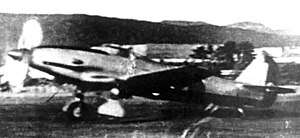Kawasaki Ki-64
The Kawasaki Ki-64 (Allied code name: Rob) was a one-off prototype of an experimental heavy, single seat, fighter. It had two unusual design features. First; it had two Kawasaki Ha-40 engines in tandem; one in the aircraft nose, the other behind the cockpit, both being connected by a drive shaft. This combination (called the Kawasaki Ha-201) drove two, three-bladed, contra-rotating propellors.[1][2] The second feature was the use of the wing surface as a radiator for the water-cooled engines.[3] The aircraft first flew in December 1943. During the fifth flight, the rear engine caught fire; and while the aircraft made an emergency landing, it was damaged. The aircraft was subsequently abandoned in mid-1944 in favour of more promising projects. The airframe survived the war, and parts of the unique cooling system were sent to Wright Field for examination.[4]
| Ki-64 | |
|---|---|
 | |
| Role | Fighter |
| Manufacturer | Kawasaki Kōkūki Kōgyō K.K. |
| First flight | December 1943 |
| Status | Cancelled 1944 |
| Primary user | Imperial Japanese Army |
| Number built | 1 |
Specifications (Ki-64)
Data from Warplanes of the Second World War, Volume Three: Fighters;[5] WW2 Aircraft Fact Files: Japanese Army Fighters, Part 1;[4] Japanese Aircraft of the Pacific War[6]
General characteristics
- Crew: 1 (pilot)
- Length: 11 m (36 ft 1 in)
- Wingspan: 13.5 m (44 ft 3 in)
- Height: 4.25 m (13 ft 11 in)
- Wing area: 28 m2 (300 sq ft)
- Empty weight: 4,050 kg (8,929 lb)
- Gross weight: 5,100 kg (11,244 lb)
- Powerplant: 1 × Kawasaki Ha-201 coupled liquid-cooled V12 engine, 1,750 kW (2,350 hp)
- Propellers: 2 × 3-bladed contra-rotating propellers
Performance
- Maximum speed: 690 km/h (430 mph, 370 kn) at 5,000 metres (16,000 ft)
- Range: 1,000 km (620 mi, 540 nmi)
- Service ceiling: 12,000 m (39,000 ft)
- Time to altitude: 5.5 minutes to 5,000 metres (16,000 ft)
- Wing loading: 182.1 kg/m2 (37.3 lb/sq ft)
- Power/mass: 2.91 kg/kW (2.17 kg/hp; 4.78 lb/hp)
Armament
- Guns: 4 × 20 mm (0.79 in) Ho-5 cannon or 2 × Ho-5 and 2 × 12.7 mm (0.50 in) Ho-103 machine guns
See also
Aircraft of comparable role, configuration and era
Related lists
References
Citations
- FAOW 76 1976, pp. 17–18; 46–47.
- Green and Swanborough 1976, p. 35.
- Green and Swanborough 1976, p. 34.
- Green and Swanborough 1976, p. 36.
- Green 1973, p. 26.
- Francillon 1979, p. 122.
Bibliography
- Francillon, Ph.D., René J. Japanese Aircraft of the Pacific War. London: Putnam & Company Ltd., 1970 (2nd edition 1979). ISBN 0-370-30251-6.
- Green, William. Warplanes of the Second World War, Volume Three: Fighters. London: Macdonald & Co. (Publishers) Ltd., 1961 (seventh impression 1973). ISBN 0-356-01447-9.
- Green, William and Swanborough, Gordon. WW2 Aircraft Fact Files: Japanese Army Fighters, Part 1. London: Macdonald and Jane's, 1976. ISBN 0-356-08224-5.
- Unknown Author(s). Famous Aircraft of the World, no.76: Japanese Army Experimental Fighters (1). Tokyo, Japan: Bunrin-Do Co. Ltd., August 1976.
External links
| Wikimedia Commons has media related to Kawasaki Ki-64. |